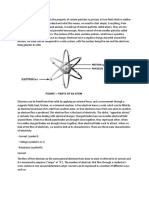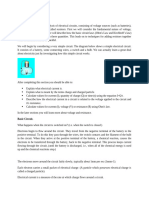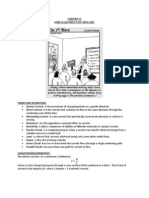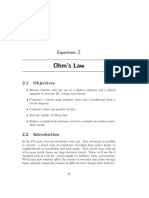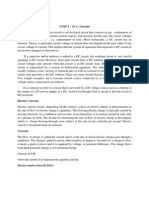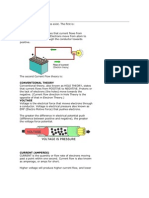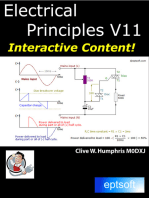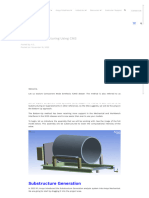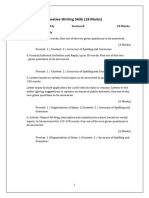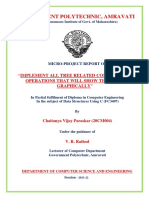Electric Circuits - Manual - 3h
Electric Circuits - Manual - 3h
Uploaded by
basketball10530Copyright:
Available Formats
Electric Circuits - Manual - 3h
Electric Circuits - Manual - 3h
Uploaded by
basketball10530Original Title
Copyright
Available Formats
Share this document
Did you find this document useful?
Is this content inappropriate?
Copyright:
Available Formats
Electric Circuits - Manual - 3h
Electric Circuits - Manual - 3h
Uploaded by
basketball10530Copyright:
Available Formats
Electric circuits (3h)
Resistances in circuits
Analogy of water flow and electric current
An electrical circuit consists of a closed loop with a number of different elements through which electric current
passes. This loop may be made up of a number of sub-loops. In order to understand the concepts of voltage,
current, resistance, and conductance, we will use the following analogy.
Consider a water pump as presented in Figure 1 below, which lifts water through a height, 𝐻, up to reservoir A,
from which the water flows down a pipe of diameter, 𝐷, to reservoir B below. The pump then takes the water from
reservoir B and pumps it back up the same height, 𝐻, to reservoir A. This water circuit is a closed loop. The pump
gives potential energy (gravitational) to the water in the same way that a battery in an electrical circuit provides
energy to the electrical charges. The height difference (𝐻) between A and B determines the magnitude of the
water droplets’ potential energy (𝐸 = 𝑚𝑔𝐻), which is released when they fall down the pipe. This is analogous to
the voltage difference between the positive and negative terminals of a battery, or any other source of voltage. It
determines the rate at which the electrical charges move (current).
The amount of droplets passing a given point in one second is analogous to the electrical current, which
corresponds to the number of electrons (with a total charge measured in Coulombs) that pass a given point in one
second. The unit of current is Amperes. The diameter of the water pipe can relate to the resistance of an electrical
component. The larger the diameter of the pipe, the greater the flow rate of water is (the smaller the diameter,
the smaller is the flow rate). Assuming the applied voltage is the same, thicker wires of the same material can carry
more current. The resistance is the ability to restrict the current flow which is measured in Ohms (Ω).
Figure 1 - Analogy of water flow and electric current for a resistor
Current convention
In the wires of electrical circuits, negatively-charged electrons carry the current. However, in other devices such as
batteries, positively-charged ions may also contribute to the current. Positive charges move in the opposite
direction to that of the electrons. Historically, the direction of electrical current is taken to be that of positive
charges.
Electric circuits (3h) 1
Ohm’s law
Ohm’s law describes the relationship between electric potential, current, and resistance. In this experiment, you
will examine how combinations of voltages and resistors affect both the energy and the flow rate of charge in
electrical circuits. Ohm’s law states that the voltage difference, ∆𝑉, across two points of an element is directly
proportional to the current, 𝐼, going through the element:
∆𝑉 = 𝑅𝐼 , (eq. 1)
with 𝑅 being the resistance of the element as discussed above. Ohm’s law implies that a plot of voltage as a
function of current in a circuit can be used to determine the resistance (the slope of the straight line graph equals
the resistance). The resistance value of commercial resistor can be obtained from colored bars printed on it (see
the Tutorial - Using a multimeter) or measured using an Ohmmeter. For combinations of more than one resistor,
methods for calculating the total resistance will be investigated during this experiment.
Kirchhoff’s rules
We can analyse a simple circuit using Ohm’s law and the rules for series and parallel combinations of resistors. For
more complex circuits we use Kirchhoff’s rules. These two rules allow one to set up sets of equations which can be
algebraically manipulated to solve for the unknown quantities (usually the current through all parts of a circuit).
The Junction Rule (Conservation of Charge):
The sum of the currents entering any junction must equal the sum of the currents leaving that
junction. A junction is any point in a circuit where the current is split or is re-joined. This first rule is a
statement of conservation of charge. Whatever current enters a given point in a circuit must leave
that point because charge cannot build or disappear.
The Loop Rule (Conservation of Energy):
The sum of the potential energy differences (voltage changes) across each element around any closed
circuit loop must be zero.
The initial step in applying Kirchhoff’s rules is to choose the direction of flow for all the currents of the circuit. In
the example shown in Figure 2, we can be certain of these directions of flow. In more complex circuits the
directions must be “guessed” and if a final result leads to a negative current, then the magnitude is still correct but
we know the direction must be changed. If we apply the junction rule to the example circuit shown, we find at the
junction labelled by point “c” we get;
𝐼1 = 𝐼2 + 𝐼3 . (eq. 2)
We know that at point “d” the two currents re-join and should be equal to 𝐼1 . Applying the junction rule at point
“d” would just give the same equation and thus no new information. The Loop Rule will be needed to continue.
The second rule is equivalent to the law of conservation of energy. Any charge that moves around a closed loop in
a circuit, on returning to its original point will have the same potential energy or V (voltage) with which it started. It
must gain as much energy as it loses.
Electric circuits (3h) 2
Figure 2 – Currents in a mixed circuit to analyze it using Kirchhoff’s rules
A charge’s energy may decrease across a resistor by ∆𝑉 = −𝐼𝑅 or increase by flowing through a power source
such as a battery from negative (–) to positive (+). However, when the charge reaches the starting point of a loop,
its energy will be back to its original level.
In the circuit shown in Figure 2, there are three possible loops that could be used to build conservation of energy
equations. However since we have three unknowns to find (𝐼1 , 𝐼2 , 𝐼3 ) and already have one independent equation
(from the Junction Rule, 𝐼1 = 𝐼2 + 𝐼3 ), we only need two additional loops to get two more equations. (i.e. with
three independent equations one can algebraically solve for three unknowns). Thus two loops are chosen as
indicated in the Figure 2 (the loops are shown inside the circuit).
For the larger loop, one starts at point “a” at zero potential and travels through the power source from negative (–
) to positive (+), giving a voltage rise of ∆𝑉0 . Passing through the first resistor gives a voltage drop that depends on
𝐼1 namely, ∆𝑉 = −𝑅1 𝐼1 . In this loop the next resistor to go through gives the final voltage drop of ∆𝑉 = −𝑅2 𝐼2
and then we return back to point “a”. Thus the second equation is:
∆𝑉0 − 𝑅1 𝐼1 − 𝑅2 𝐼2 = 0. (eq. 3)
The second loop chosen has no source of potential but if we examine the behaviour of a test charge forced around
this loop, its potential will drop when passing through a resistor in the same direction as the current OR will rise if
going the opposite direction of the current (like going up or down a waterfall). Thus if we pick point “c” as the
starting point then we are traveling with the current through resistor 𝑅2 (voltage drops) and go against the current
through resistor 𝑅3 (voltage rises) and we return back to “c”. This gives the equation:
−𝑅2 𝐼2 + 𝑅3 𝐼3 = 0. (eq. 4)
We now have three equations (eqs. 2, 3, and 4) and three unknowns (𝐼1 , 𝐼2 , 𝐼3 ). You can now choose any way to
solve the three equations and determine the unknown currents.
Electric circuits (3h) 3
Capacitors in circuits
Analogy to the capacitor in electrical circuit
An example of a capacitor (shown in Figure 3), is a hollow sphere which is divided into two equal volumes, A and B,
with a flexible rubber circular sheet separating them. The sphere is filled with water and it has two valves. The two
valves are connected to a pump. When you turn on the pump, it pulls water from division A and pushes it into
division B. As a result of the work done on the water, the rubber sheet is distorted and an elastic energy is stored
in it. Divisions A and B are analogous to the two plates of the capacitor. The pump is analogous to the battery. The
rubber sheet is analogous to the dielectric material between the plates. The elastic energy stored in the rubber
sheet is analogous to electrical energy stored in the capacitor. It is important to mention that we did not add water
to the sphere; we transfer water from A to B. The result is storing elastic energy. Similarly, we do not add charges
to the capacitor when we “charge” it, we simply transfer charges from one plate to the other. The result is storing
electrical energy in the capacitor.
Figure 3 - Analogy of water and electric current for a capacitor
Suggested reading
Students taking Suggested reading
PHY 1122 Section 24.2, Young, H. D., Freedman, R. A., University Physics with Modern
Chapters 25 and 26 Physics, 13th edition. Addison-Wesley (2012).
PHY 1322 Section 26.3, Serway, R. A., Jewett, J. W., Physics for Scientists and Engineers
Chapters 27 and 28 with Modern Physics, eight edition. Brooks/Cole (2010).
PHY 1124 Section 25.4, Halliday, D., Resnick, R., Walker, J., Fundamentals of Physics, 9th
Chapters 26 and 27 edition. Wiley (2011).
Electric circuits (3h) 4
Objectives
Part 1 – Measuring a resistance value
Read the colour coded value of a resistor.
Use an Ohmmeter.
Part 2 – Ohm’s law
Prepare circuits on a solderless breadboard.
Use a voltmeter and an ammeter.
Investigate all variables involved in the Ohm’s law relationship.
Part 3 – Combination of resistors
Investigate simple electrical circuits: series, parallel, and mixed.
Understand the effective resistance concept.
Part 4 – Voltages and currents in circuits (Kirchhoff’s rules)
Experimentally verify the Kirchhoff’s rules of circuit analysis for a simple example.
Part 5 – Capacitance and combinations of capacitors
Understand the effective capacitance concept.
Materials
Computer equipped with Logger Pro
Computer equipped with the National Instrument myDAQ virtual instruments
National Instrument myDAQ data acquisition system
Wire kit and breadboard
Resistors (470 , 1 k and 3.3 k) and capacitors (0.1 F and 0.22 F)
Safety warnings
You should always disconnect your circuit from the power source to use the Ohmmeter. You should also always
double check your circuit before adding the power source. In case of doubt, ask your TA to verify your circuit.
References for this manual
Dukerich, L., Advanced Physics with Vernier – Beyond mechanics. Vernier software and Technology (2012).
Basic Electricity. PASCO scientific (1990).
User guide and specifications for the NI myDAQ
Electric circuits (3h) 5
Procedure
Part 1 – Measuring a resistance value
Step 1. Based on the colour codes in Table 1, identify the three resistors 𝑅1 , 𝑅2 and 𝑅3 .
Step 2. Using the resistor colour chart in the Tutorial - Using a multimeter, identify the resistance values of the
three resistors and complete columns 3, 4 and 5 of Table 1.
Step 3. Using the Fluke multimeter (the yellow one), measure the resistance values of the three resistors.
- Select the symbol.
- Connect the black and red cable with alligator clips to both branches of one resistor.
- Record the resistance value and complete columns 6 and 7 of Table 1. Use an uncertainty of
±1% to complete column 7.
Step 4. Compare the colour coded value with your measurement and complete the last column of Table 1.
Part 2 – Ohm’s law
Step 1. Turn on your computer and launch the Digital Multimeter and the DC Level (power supply) programs
(these programs should be available in the NIElvis folder from the computer’s desktop).
Step 2. Assemble the circuit below using your 1 k resistor, the Fluke multimeter as a voltmeter and the
myDAQ multimeter as an ammeter. The power supply is the red and black wires labelled AO0 and AGND
coming out of your myDAQ unit. Refer to the tutorials in order to make the proper connections.
Optional: Ask your TA to verify your circuit before going to the next step.
Step 3. Select the DC current ammeter in the myDAQ multimeter window (third button in the Measurement
Settings section). Select Auto in the Mode menu. Click Run to start making measurements.
Step 4. Set the Voltage Level of the power supply to 0.25 V. Make sure the Channel Settings is set to
myDAQ1/ao0. Click Start to turn the power on. Read the voltage and the current using your
multimeters. Enter the values in Table 2.
Electric circuits (3h) 6
Step 5. Increase the voltage by 0.25 V. Repeat the measurements and complete Table 2. Click STOP to turn off
the power supply.
Step 6. Launch the Logger Pro program. Prepare a graph of the Voltage at the resistor (in V) vs. Current (in A).
This is your Graph 1. Arrange your graph to get a proper display according to the tutorial How to prepare
a graph.
Step 7. Perform a linear fit of Graph 1. Select the graph, click Analyze then Linear Fit.
Step 8. Save your Graph 1.
Click File then Page Setup… and select the Landscape orientation. Click OK.
Select File then Print Graph…. When the printing options windows opens, add your name and
the one of your partner(s) in the field Name:. Click OK.
Make sure to select the CutePDF as a printer and click OK again.
Save your graph on the computer. You will need to upload this graph in Brightspace.
Step 9. We strongly recommend that you save all the work you do during the lab in case you need to review it
later. Click File/Save As… to save your experiment file (suggested name: Ohm_YOUR_NAMES.cmbl). You
can either send the file to yourself by email or save it on a USB key.
Part 3 – Combination of resistors
Step 1. Using the ohmmeter, measure the effective resistance of various combinations of resistors in series to
complete Table 3. Assemble your resistors in series using the breadboard.
Step 2. Using the ohmmeter, measure the effective resistance of various combinations of resistors in parallel to
complete Table 4. Assemble your resistors in parallel using the breadboard.
Step 3. Using the ohmmeter, measure the effective resistance of resistor 1 in series with resistors 2 and 3 in
parallel (see below). Assemble this mixed circuit using the breadboard.
Electric circuits (3h) 7
Part 4 – Voltages and currents in circuits (Kirchhoff’s rules)
Step 1. Add a power supply to the mixed circuit you just worked with. Set the power supply to 2 V, turn it on
and measure the voltage drops (∆𝑉0 , ∆𝑉1 and ∆𝑉2//3 ) and the currents (𝐼1 , 𝐼2 and 𝐼3 ) going through each
branch of the circuit as labelled below. As before, use the Fluke voltmeter for your voltage
measurements and the myDAQ ammeter to measure your currents. You should measure each voltage
and current individually. Turn off the power supply when you are done.
Part 5 – Capacitance and combinations of capacitors
Step 1. Using the Fluke multimeter, measure the capacitance values of the two capacitors provided (𝐶1 : 0.1 F
and 𝐶2 : 0.22 F). Enter the values in Table 5.
Step 2. Measure the effective capacitance of these two capacitors connected in series or in parallel. Assemble
your capacitors using the breadboard and complete Table 5.
Cleaning up your station
Step 1. If you locally saved your files, send them to yourself by email. Pick up your USB key if you used one to
save your files. Turn off the computer.
Step 2. Turn off the Fluke multimeter. Disassemble your circuit and put all wires, the three resistors, and the
two capacitors back in the wire kit.
Step 3. Please recycle scrap paper and throw away any garbage. Please leave your station as clean as you can.
Step 4. Push back the monitor, keyboard and mouse. Also please push your chairs back under the table.
Electric circuits (3h) 8
You might also like
- EEE201Document161 pagesEEE201otarus497No ratings yet
- Inventory ExampleDocument14 pagesInventory ExampleSrijan Shetty100% (1)
- Ohms LawDocument25 pagesOhms LawLui PorrasNo ratings yet
- KVGC 102 - R8552BDocument166 pagesKVGC 102 - R8552BDIEGONo ratings yet
- EE331 Lecture1 NotesDocument21 pagesEE331 Lecture1 NotespaulamarieestrellalengascoNo ratings yet
- Learning Objectives:: V I R Voltage Current ResistanceDocument7 pagesLearning Objectives:: V I R Voltage Current ResistanceEfrainNo ratings yet
- Experiment 1-Introduction To Electronic Equipment: PurposeDocument17 pagesExperiment 1-Introduction To Electronic Equipment: PurposeGustavo Alejandro NaranjoNo ratings yet
- English WorkDocument11 pagesEnglish WorkGilda TangataNo ratings yet
- Chapter 28-Direct Current CircuitsDocument47 pagesChapter 28-Direct Current CircuitsGled HysiNo ratings yet
- PHY 102 NoteDocument14 pagesPHY 102 NoteÇzãr MãlõñëNo ratings yet
- Unit 9 NotesDocument17 pagesUnit 9 Notesyooh9814No ratings yet
- Ch-11 Electricity and MagDocument56 pagesCh-11 Electricity and MagTakkee BireeNo ratings yet
- 2 Ohm's Law: ExperimentDocument25 pages2 Ohm's Law: ExperimentSabling DritzcNo ratings yet
- Lesson 2 Resistive Circuit CalculationsDocument9 pagesLesson 2 Resistive Circuit CalculationsBlueprint MihNo ratings yet
- CHAPTER 15 - Electric CircuitsDocument6 pagesCHAPTER 15 - Electric CircuitsGerry Lou QuilesNo ratings yet
- Circuits: Electric ChargeDocument10 pagesCircuits: Electric ChargeOpemipo OlorunfemiNo ratings yet
- Special AssignmentDocument11 pagesSpecial Assignmentmanahilnasir67No ratings yet
- DC CircuitsDocument26 pagesDC CircuitsMary Jean ParagsaNo ratings yet
- Topics To Be Covered: Unit-2: Basic Circuit ElementsDocument11 pagesTopics To Be Covered: Unit-2: Basic Circuit ElementsParthaNo ratings yet
- Ohms LawDocument25 pagesOhms LawToinkNo ratings yet
- Network Theorems: Up Previous Chapter 2: Circuit Principles Solving Circuits With KirchoffDocument10 pagesNetwork Theorems: Up Previous Chapter 2: Circuit Principles Solving Circuits With KirchoffnikolakaNo ratings yet
- Chapter 2 DC Circuit TheoryDocument37 pagesChapter 2 DC Circuit TheoryTynoh MusukuNo ratings yet
- Unit-1 2Document20 pagesUnit-1 2Akhilesh Kumar MishraNo ratings yet
- الدوائر الكهربائية من 1 لغاية 8 1Document60 pagesالدوائر الكهربائية من 1 لغاية 8 1abbas00170No ratings yet
- Chapter 1 Basic ElectricityDocument26 pagesChapter 1 Basic ElectricityBirhex FeyeNo ratings yet
- Ee303 1Document10 pagesEe303 1api-288751705No ratings yet
- Current Electricity (Notes)Document27 pagesCurrent Electricity (Notes)cvgbhnjNo ratings yet
- Chapter 27-Current and ResistanceDocument21 pagesChapter 27-Current and ResistanceGled HysiNo ratings yet
- Experiment I: Ohm's Law and Not Ohm's LawDocument14 pagesExperiment I: Ohm's Law and Not Ohm's LawPhillip PopeNo ratings yet
- ElectricityDocument23 pagesElectricityRishi BhatiaNo ratings yet
- Module 1 (The Electric Circuits)Document11 pagesModule 1 (The Electric Circuits)Xavier Vincent VisayaNo ratings yet
- E109 - AgustinDocument25 pagesE109 - AgustinSeth Jarl G. AgustinNo ratings yet
- Chapter 2: DC Circuit TheoryDocument37 pagesChapter 2: DC Circuit TheoryTaonga Nhambi100% (1)
- 2 Ohm's Law: ExperimentDocument25 pages2 Ohm's Law: ExperimentAkshay PabbathiNo ratings yet
- Electricity-As Level Physics NotesDocument10 pagesElectricity-As Level Physics Noteschar100% (1)
- DC Component AnalysisDocument9 pagesDC Component Analysisvivianzhu120No ratings yet
- Physics 2Document47 pagesPhysics 2JURIS LHUINo ratings yet
- Electricity Has An Important Place in Modern SocietyDocument18 pagesElectricity Has An Important Place in Modern SocietyratanlourembamNo ratings yet
- Basic Principles of Ohm'S Law: Prepared by Training & Calibration Services Department Healthtronics (M) SDN BHD MalaysiaDocument46 pagesBasic Principles of Ohm'S Law: Prepared by Training & Calibration Services Department Healthtronics (M) SDN BHD MalaysiaAhmad Damanhuri Mohd YunusNo ratings yet
- Chapter 13 Electrical Quantities in Circuits LESSONS (22-23) 2Document54 pagesChapter 13 Electrical Quantities in Circuits LESSONS (22-23) 2irum qaisraniNo ratings yet
- Electronics Engineering Notes Unit 1st YearDocument11 pagesElectronics Engineering Notes Unit 1st Yearmahvs.1311No ratings yet
- Student Chiya Abdulrahman HusseinDocument6 pagesStudent Chiya Abdulrahman Husseinanormal personNo ratings yet
- What is Voltage_ _ Voltage Formula & Units _ Study.comDocument9 pagesWhat is Voltage_ _ Voltage Formula & Units _ Study.comedos izedonmwenNo ratings yet
- ELE 115 Basic ElectricityDocument4 pagesELE 115 Basic ElectricityEuropez AlaskhaNo ratings yet
- Module1 1Document46 pagesModule1 1Disha GoyalNo ratings yet
- Electrical Engineering111Document22 pagesElectrical Engineering111sammy kyaloNo ratings yet
- Awejfniauwcenifucawefniuwneif 6Document31 pagesAwejfniauwcenifucawefniuwneif 6iuahweifuawheNo ratings yet
- Magnetic Fields and Electric CurrentDocument11 pagesMagnetic Fields and Electric CurrentRaghav MehtaNo ratings yet
- Educ376 Electrical Circuits Instructional MaterialsDocument30 pagesEduc376 Electrical Circuits Instructional Materialsapi-583788842No ratings yet
- E306 Report - Parallel and Series CircuitsDocument5 pagesE306 Report - Parallel and Series CircuitsAbdul Rahman Mariscal100% (1)
- ElectricalDocument35 pagesElectricalvinomalai100% (1)
- Basic Electrical TheoryDocument6 pagesBasic Electrical TheoryMohd Ziaur Rahman RahmanNo ratings yet
- Unit 1 PDFDocument43 pagesUnit 1 PDFabhi shekNo ratings yet
- Chapter 2 Ohms Law, Series and Parallel Circuit PDFDocument6 pagesChapter 2 Ohms Law, Series and Parallel Circuit PDFMamaZote TechNo ratings yet
- Beee Unit I-9-16Document8 pagesBeee Unit I-9-16RAJASHEKHARNo ratings yet
- Electricity and MagnetismDocument29 pagesElectricity and MagnetismNashrul HaqNo ratings yet
- Chapter 1 Introductory Concepts: ECEG-1351 - Fundamentals of Electric CircuitsDocument18 pagesChapter 1 Introductory Concepts: ECEG-1351 - Fundamentals of Electric CircuitsSolomon AsefaNo ratings yet
- 1 Electric CircuitDocument6 pages1 Electric CircuitRazi HaziqNo ratings yet
- DC and Ac NetworksDocument12 pagesDC and Ac NetworksEzekiel JamesNo ratings yet
- Gustav KirchhoffDocument25 pagesGustav KirchhoffSICEL GRACE AMODIANo ratings yet
- Bottom-Up Substructuring Using CMSDocument9 pagesBottom-Up Substructuring Using CMSprangyaNo ratings yet
- Use of Corona Rings To Control The Electrical Field Along Transmission Line Composite InsulatorsDocument25 pagesUse of Corona Rings To Control The Electrical Field Along Transmission Line Composite InsulatorsJohn HarlandNo ratings yet
- PM Debug InfoDocument104 pagesPM Debug Infomingboyevashahlo4No ratings yet
- Module 1 - Introduction To HibernateDocument15 pagesModule 1 - Introduction To Hibernateshaik abdullaNo ratings yet
- Final SetsDocument13 pagesFinal SetsDasaradha Rami Reddy VNo ratings yet
- AssignmentDocument38 pagesAssignmentUltra ChannelNo ratings yet
- User Story Mapping Workshop Checklist & TemplateDocument4 pagesUser Story Mapping Workshop Checklist & TemplateSathish CNo ratings yet
- SUNStudent Student Portal UserGuideDocument13 pagesSUNStudent Student Portal UserGuidetshedzanemalili87No ratings yet
- 2.1 Relocation Preparation Procedure Modification: TSGR3#7 (99) C24Document4 pages2.1 Relocation Preparation Procedure Modification: TSGR3#7 (99) C24David JhNo ratings yet
- Jean-Pierre MENA: Curriculum VitaeDocument4 pagesJean-Pierre MENA: Curriculum VitaeMehrdad RastegarNo ratings yet
- Drop BoxDocument45 pagesDrop BoxDanyNo ratings yet
- Ts 7400 DatasheetDocument1 pageTs 7400 DatasheetmanteshbNo ratings yet
- Writing SectionDocument15 pagesWriting SectionUpma GandhiNo ratings yet
- PHYS106 Lecture 1Document5 pagesPHYS106 Lecture 1conchoNo ratings yet
- Log Connwa 2023-12-22Document43 pagesLog Connwa 2023-12-22n8g8mhxfwtNo ratings yet
- Ploting With Pyplot Data Visualization Worksheets1!5!279202323752Document10 pagesPloting With Pyplot Data Visualization Worksheets1!5!279202323752pnchaitanyaaNo ratings yet
- Assignment 2 (School Plant)Document6 pagesAssignment 2 (School Plant)princess nicole lugtuNo ratings yet
- An Analysis of Effectiveness On Digital Marketing StrategiesDocument60 pagesAn Analysis of Effectiveness On Digital Marketing StrategiesPreethu GowdaNo ratings yet
- Leica Viva TS16 DSDocument2 pagesLeica Viva TS16 DSFlorentina CrangasuNo ratings yet
- Classes and Objects Part 1Document9 pagesClasses and Objects Part 1Sadiq AhmadNo ratings yet
- Preload InstallerDocument8 pagesPreload Installerstefan ungureanNo ratings yet
- Duplex Anaesthetic Gas Scavenging Plant (Agss) : Phoenix P Ipeline Pro Duct S Lim I Te DDocument4 pagesDuplex Anaesthetic Gas Scavenging Plant (Agss) : Phoenix P Ipeline Pro Duct S Lim I Te DanfalapNo ratings yet
- ASIC Interview Question & Answer - Verilog Interview QuestionsDocument18 pagesASIC Interview Question & Answer - Verilog Interview Questionsvasav1No ratings yet
- Avamar Common IssueDocument5 pagesAvamar Common IssueGopi PanchumarthiNo ratings yet
- 20CM004 Dsa MP ReportDocument6 pages20CM004 Dsa MP ReportChaitanya ParaskarNo ratings yet
- Algorithm Design Paradigm-2 PDFDocument28 pagesAlgorithm Design Paradigm-2 PDFYukti SatheeshNo ratings yet
- Complete Answer Guide for CISSP Guide to Security Essentials 2nd Edition Gregory Solutions ManualDocument32 pagesComplete Answer Guide for CISSP Guide to Security Essentials 2nd Edition Gregory Solutions Manualaichisaade100% (4)
- BA InductionDocument9 pagesBA InductionShubham SinghNo ratings yet


